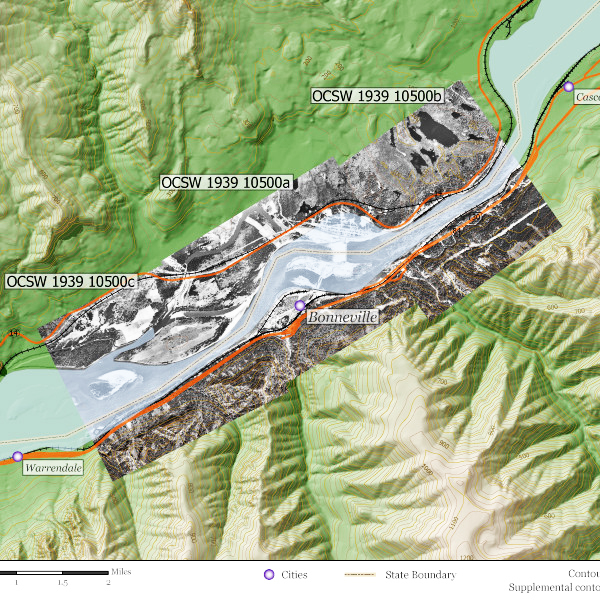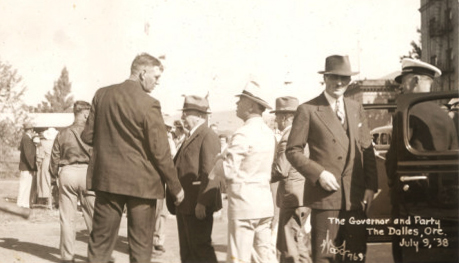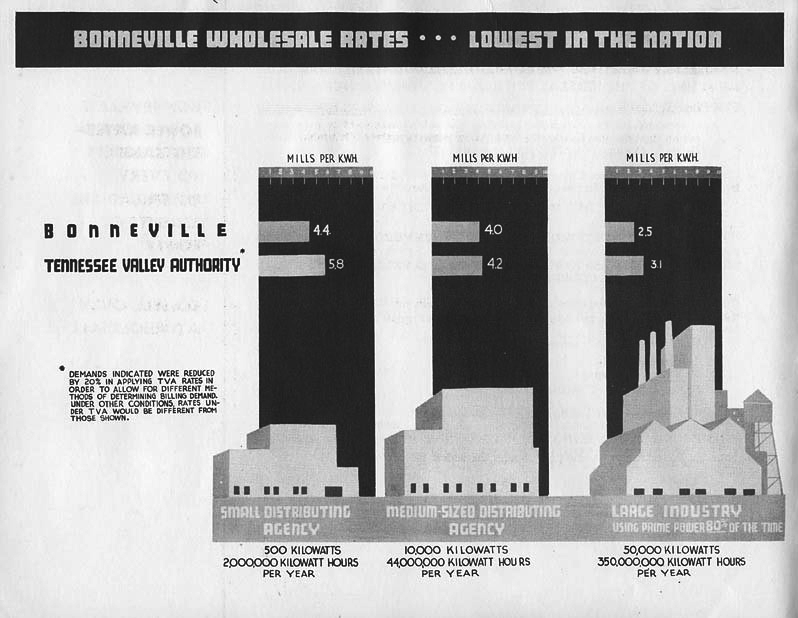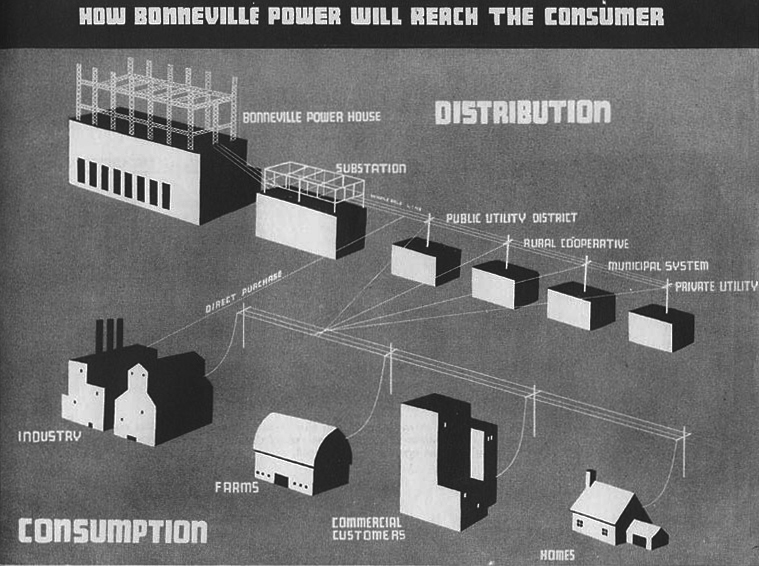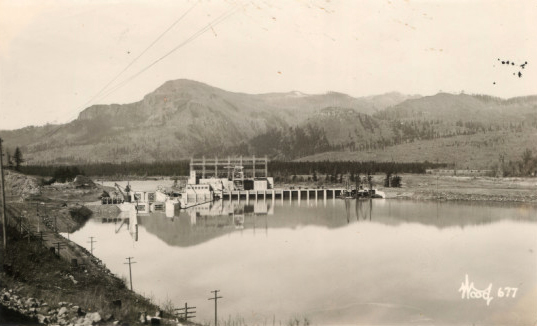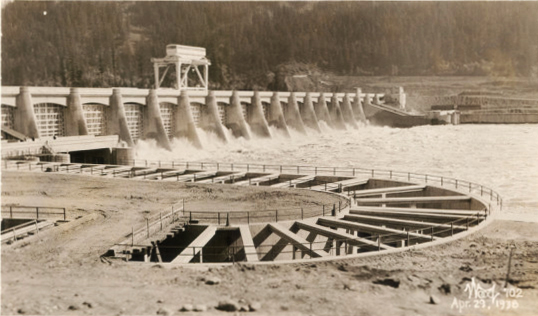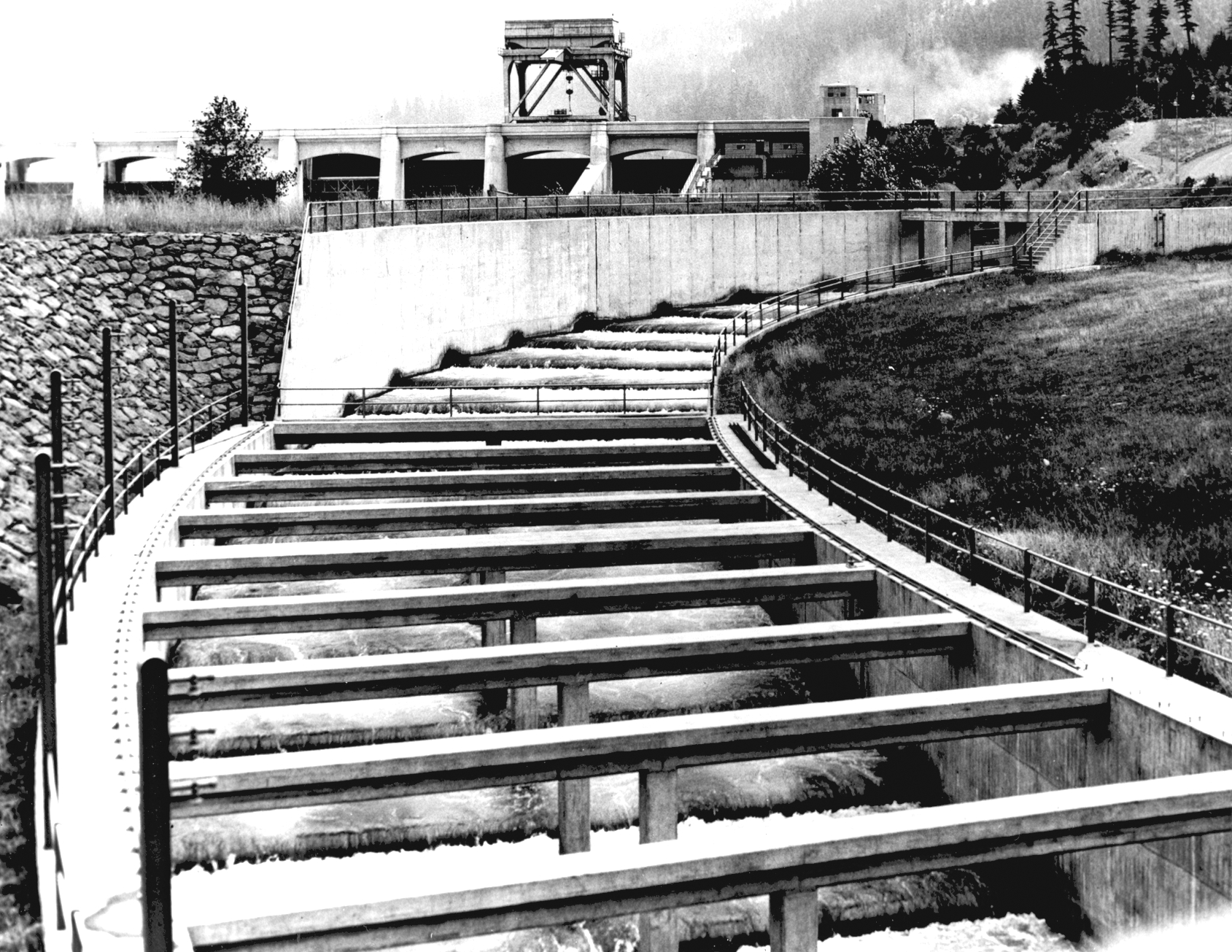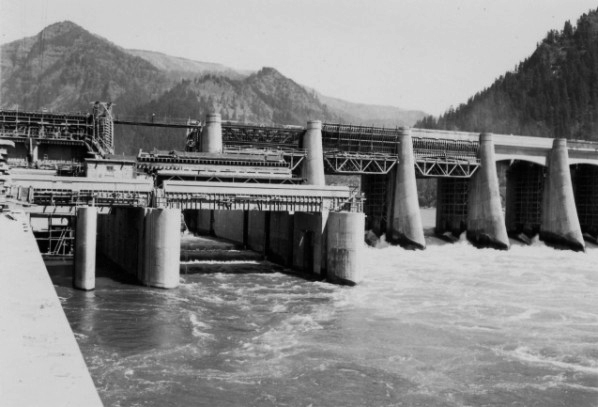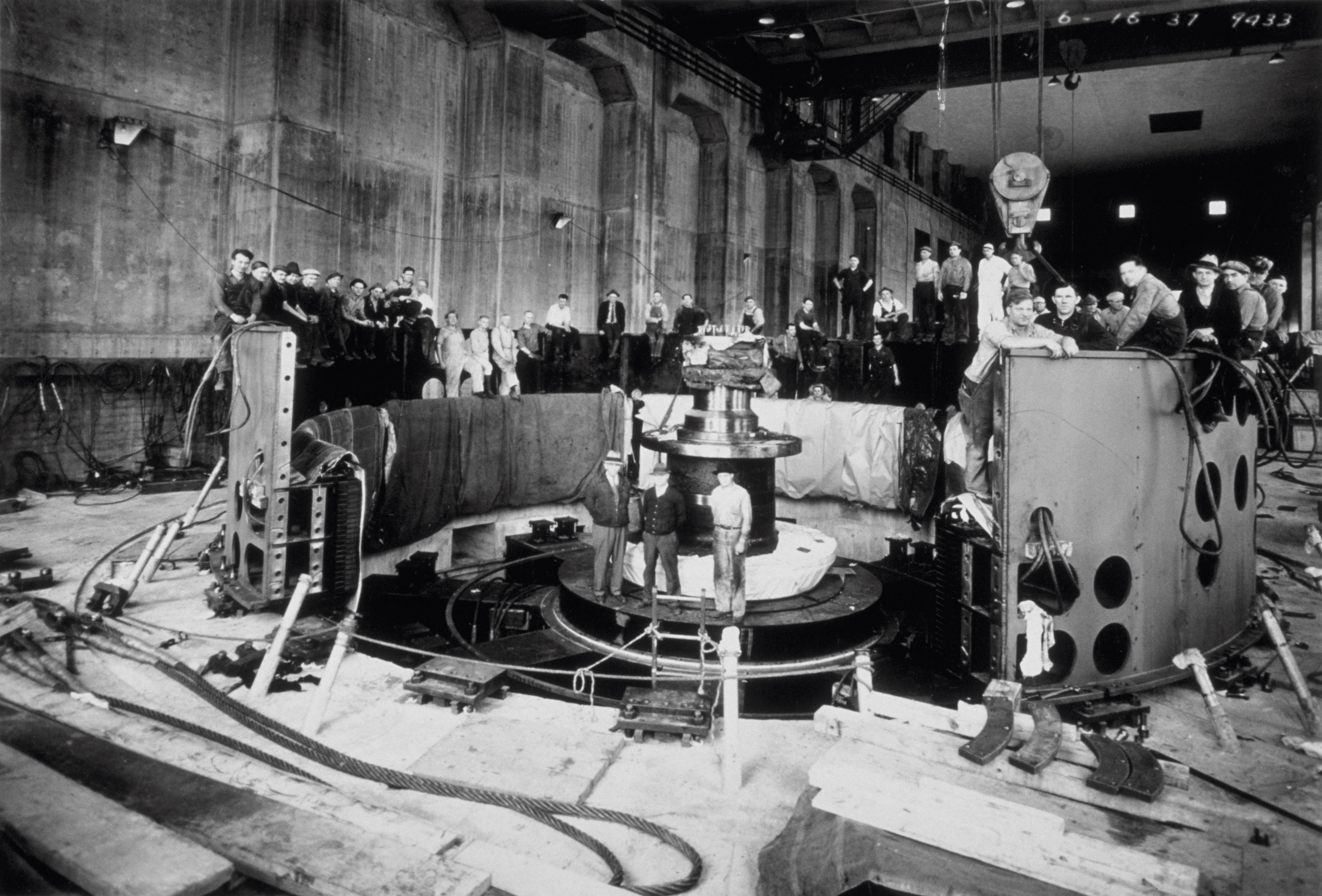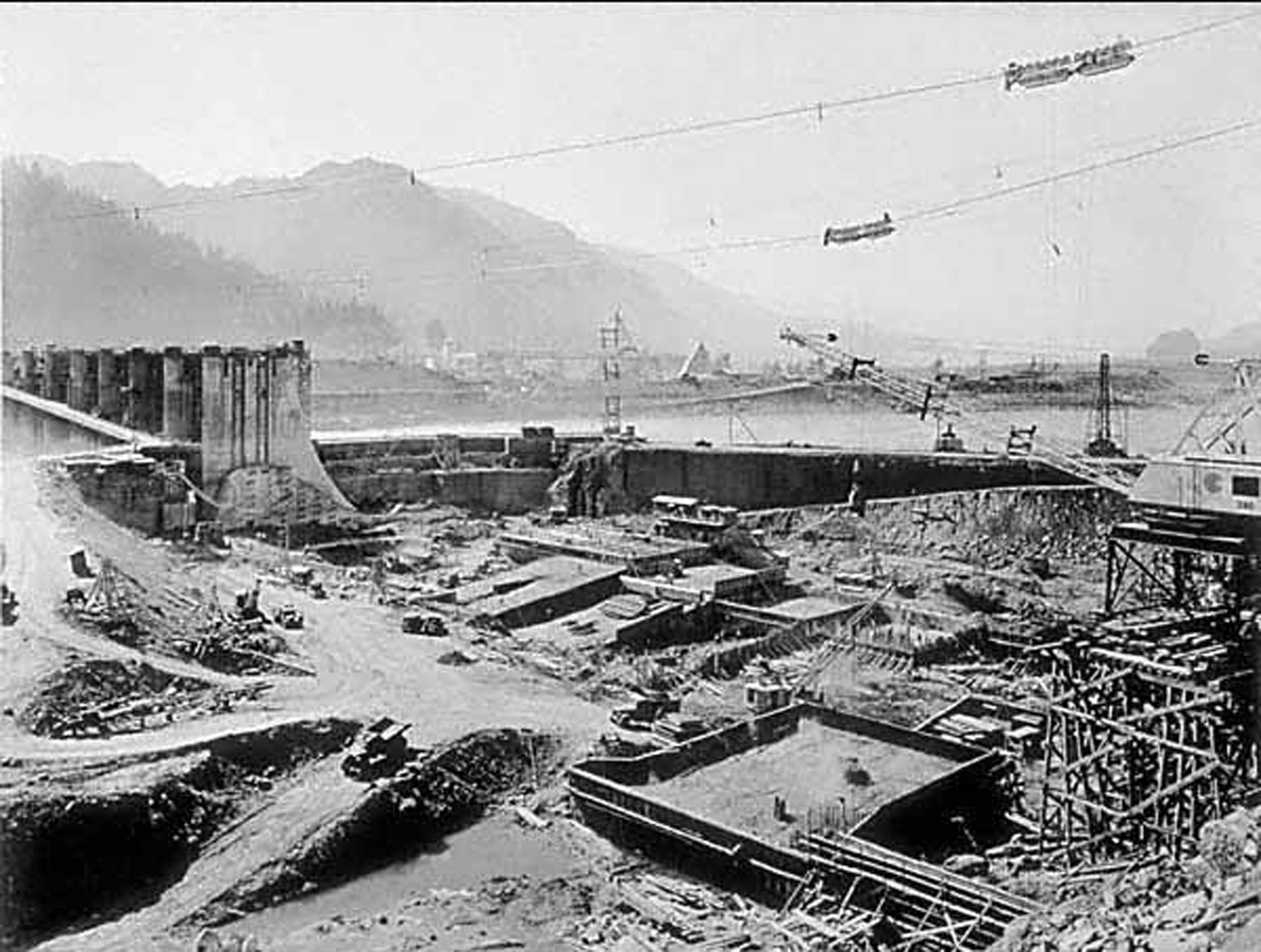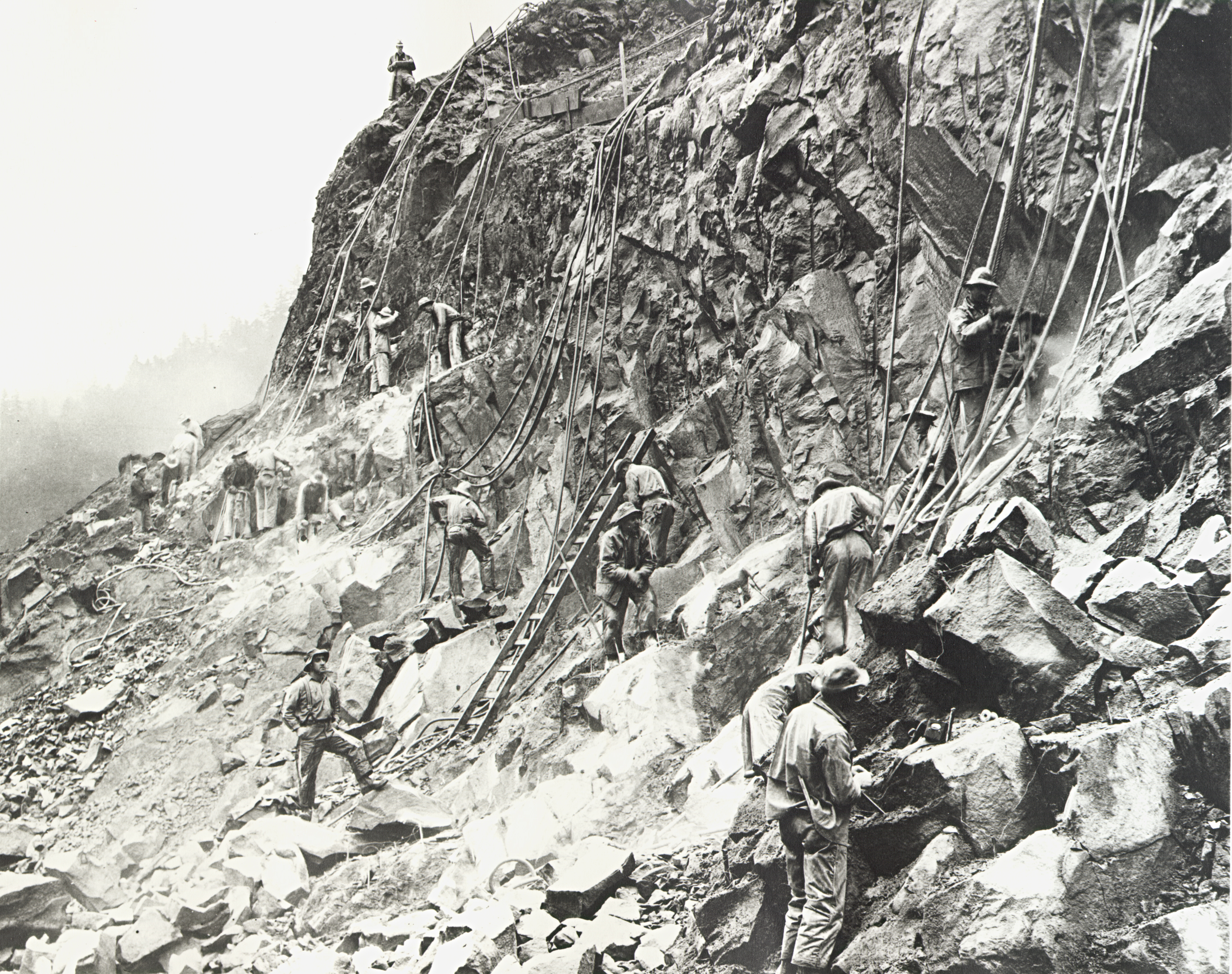The U.S. Army Corps of Engineers built and operated Bonneville Lock and Dam as the first of eight federal locks and dams on the Columbia and Snake Rivers. Located 41 miles upriver from the mouth of the Willamette, Bonneville Dam impounds a 48-mile-long reservoir with a pool elevation of 76.5 feet. The dam is located at the farthest reach of tide from the Pacific Ocean and is named for Captain Benjamin Bonneville, an early nineteenth-century army explorer and booster of the Oregon Country.
Because of the complex geology of the Columbia River Gorge, engineers found site selection a difficult process. The original Warrendale site was rejected in favor of the Bonneville site at the north end of Bradford Island, where bedrock provided a solid foundation for the dam.
The impetus for building Bonneville Dam stemmed from the need to alleviate unemployment during the Great Depression and to provide electric power for economic development in the Pacific Northwest. In 1932, while campaigning for the presidency, Franklin D. Roosevelt called attention to the “vast possibilities of power development on the Columbia River.” He promised that, if elected, “the next hydroelectric development to be undertaken by the Federal Government must be on the Columbia River.” Because other public works projects competed for federal funds, however, only strenuous lobbying by Oregon Senator Charles McNary and Representative Charles Martin won President Roosevelt’s ultimate authorization for the dam.
Constructed between 1933 and 1938, Bonneville Dam originally consisted of a spillway 1,450 feet long, 132 feet wide at its base, and 197 feet high above the lowest bedrock; a powerhouse 1,027 feet long and 190 feet in width and height; and a navigation lock with a chamber 500 feet long and 76 feet wide. The gravity concrete spillway contained 18 steel gates that were fifty feet wide. The original powerhouse had 10 generators, which were placed in operation between 1938 and 1944 and had a generating capacity of 526,700 kw of power. In 1981, the Corps added a second powerhouse with eight generators, producing 558,200 kw. To meet the needs of increased barge traffic on the Columbia River, in 1993 the Corps built a larger navigation lock, with a chamber 675 feet long and 86 feet wide.
Design and construction of the Bonneville project presented engineering challenges. The spillway, for example, had to achieve stability on a weak foundation rock while also being able to pass a large and variable streamflow. By combining the massive weight of the structure with a foundation poured in steps or notches, the engineers established a stable base. They coped with the widely variable streamflow by using exceptionally large steel gates set in deep slots between reinforced concrete piers.
The powerhouse design had to accommodate large quantities of water at comparatively low head but with wide seasonal variation. The solution called for using Kaplan adjustable-blade turbines, combined with large intake structures, concrete scroll cases, and deep draft tubes. In designing the navigation lock, engineers overcame difficult and dangerous moorings of vessels at low stages of the river by designing and installing a series of floating mooring bits in the lock walls. At the time of installation, the Bonneville lock, with a vertical lift of 60 feet, was the highest single-lift lock in the world.
Construction of the dam had to overcome numerous problems, including the depth of water, current velocity, harsh weather conditions, and the annual summer flood. After extensive hydraulic studies, the engineers devised a plan using massive timber cribs to divert the river from the spillway work site. Each coffer dam, placed in half of the river at a time, consisted of three lines of cribs, forming an open U, with shore arms diagonal to the river leg, which extended 460 feet. The coffer dams, shaped to fit the contours of the bedrock in the riverbed, consumed eight million board feet of timber. At the time, it was the largest coffer-dam job attempted on an American river.
Construction of the Bonneville project required placing one million cubic yards of concrete, removing 741,960 cubic yards of material from the powerhouse and lock sites, and relocating miles of highway and railroads. At the peak of construction, the total workforce averaged about 3,000, most of them from the relief rolls in Oregon and Washington. The total cost of the original Bonneville project was $83 million.
In 1937, Congress created the Bonneville Power Administration to market the power produced by Bonneville Dam. The Bonneville Power Act gave preference to publicly and cooperatively owned distribution systems, and the new agency adopted a policy of a blanket rate along the entire transmission system. In 1941 the BPA hired folk singer Woody Guthrie to compose songs to help inform the public about the benefits from Bonneville and other Columbia River hydroelectric facilities.
The Corps recognized early in its planning for Bonneville and other Columbia River dams that such structures would have to accommodate the annual runs of salmon and steelhead trout. The original plans for Bonneville, submitted in 1931, included fishways with cost estimates. Fish passage facilities on the scale required had never been attempted, so the Corps assembled a team of fisheries experts to devise a plan for passing migratory fish upstream and fingerlings downstream. The fishways consisted of lift, ladders, and a novel collection and bypass system. The proposed fish passage facilities underwent continued refinement as they were incorporated into the spillway and powerhouse structure and succeeded when put to the test upon closure of the dam.
Over time, however, the Corps found that construction of additional dams on the Columbia and its tributaries created new problems for adromonous fish that imperiled their survival as a species. Construction of the Bonneville project also necessitated considerable redesign and relocation of the large Oregon fish hatchery facilities at Bonneville. Finally, the federal government promised to create in-lieu fishing locations for the Native Americans who lost fishing sites in the pool behind the dam. Initially, only three of the fifty promised sites were completed.
In 1986, the Bonneville Lock and Dam project was placed on the National Register of Historic Places; it was later elevated to National Historic Landmark status. The Corps also operates the Bonneville project for recreation, providing opportunities for hiking, boating, fishing, swimming, and windsurfing. Several visitor centers provide information on fish migration and the operation of the powerhouse and navigation lock.
-
![Bonneville Dam, April 29, 1938.]()
Bonneville Dam 2, Apr 1938.
Bonneville Dam, April 29, 1938. Oreg. State Univ. Archives, Wasco County Pioneer Assoc., WCPA 186B-2
-
![Index map to accompany 1939 U.S. Army Corps of Engineers aerial photos of Bonneville Dam.]()
Bonneville Dam, aerial index, 1939.
Index map to accompany 1939 U.S. Army Corps of Engineers aerial photos of Bonneville Dam. Univ. of Oreg. Libr., Document Ctr., Map & Aerial Photo Collec.,, ORU_WMAP_001
-
![Bonneville Dam, July 9, 1938.]()
Bonneville Dam 3, Jul 1938.
Bonneville Dam, July 9, 1938. Oreg. State Univ. Archives, Wasco County Pioneer Assoc., WCPA 186B-8
-
![Dignitaries at Bonneville Dam, July 9, 1938, including Oregon Governor Charles Martin (center, with dark suit and hat).]()
Bonneville Dam 2, Jul 1938.
Dignitaries at Bonneville Dam, July 9, 1938, including Oregon Governor Charles Martin (center, with dark suit and hat). Oreg. State Univ. Archives, Wasco County Pioneer Assoc., WCPA 186B-26
-
![Bonneville Power Admin. pamphlet "Columbia River Power and the Northwest," p. 16, 1940.]()
Columbia River Power and the Northwest, 1940, p16.
Bonneville Power Admin. pamphlet "Columbia River Power and the Northwest," p. 16, 1940. Univ. of Oreg. Libr., ORU_WTXT_022
-
![Bonneville Power Admin. pamphlet "Columbia River Power and the Northwest," p. 31, 1940.]()
Columbia River Power and the Northwest, 1940, p31.
Bonneville Power Admin. pamphlet "Columbia River Power and the Northwest," p. 31, 1940. Univ. of Oreg. Libr., ORU_WTXT_022
-
![Bonneville Power Admin. pamphlet "Columbia River Power and the Northwest," p. 26, 1940.]()
Columbia River Power and the Northwest, 1940, p26.
Bonneville Power Admin. pamphlet "Columbia River Power and the Northwest," p. 26, 1940. Univ. of Oreg. Libr., ORU_WTXT_022
-
![Bonneville Dam, about July, 1938.]()
Bonneville Dam, ca Jul 1938.
Bonneville Dam, about July, 1938. Oreg. State Univ. Archives, Wasco County Pioneer Assoc., WCPA 186B-7
-
![Ship passing through locks of Bonneville Dam, July 9, 1938.]()
Bonneville Dam, Jul 1938.
Ship passing through locks of Bonneville Dam, July 9, 1938. Oreg. State Univ. Archives, Wasco County Pioneer Assoc., WCPA 186B-20
-
![Fish ladder at Bonneville Dam, April 29, 1938.]()
Bonneville Dam, Apr 1938.
Fish ladder at Bonneville Dam, April 29, 1938. Oreg. State Univ. Archives, Wasco County Pioneer Assoc., WCPA 186B-1
-
![U.S. Army Corps of Engineers' aerial photo of Bonneville Dam, 1939.]()
Bonneville Dam, aerial, 1939.
U.S. Army Corps of Engineers' aerial photo of Bonneville Dam, 1939. Univ. of Oreg. Libr., Document Ctr., Map & Aerial Photo Collec.,, ORU_WMAP_001
-
![Fish ladders at Bonneville Dam.]()
Bonneville Dam, fish ladder at, CN 010651.
Fish ladders at Bonneville Dam. Oreg. Hist. Soc. Research Libr., CN 010651
-
![Temporary fish ladder at the Bonneville Dam on the Washington side, July 1937.]()
Bonneville Dam, temp fish ladder, Jul 1937.
Temporary fish ladder at the Bonneville Dam on the Washington side, July 1937. Oreg. State Univ. Archives, Pac. NW Stream Survey Collec., 1-E-1:12
-
![Bonneville Dam interior during construction.]()
Bonneville Dam, interior, OrHi 97444.
Bonneville Dam interior during construction. Oreg. Hist. Soc. Research Libr., OrHi 97444
-
![Construction at Bonneville Dam, 1936.]()
Bonneville Dam, construction, 1936, OrHi 094329.
Construction at Bonneville Dam, 1936. Oreg. Hist. Soc. Research Libr., OrHi 094329
-
![Preparing Bonneville Dam site, 1935.]()
Bonneville Dam, site prep, OrHi 67724.
Preparing Bonneville Dam site, 1935. Oreg. Hist. Soc. Research Libr., OrHi 67724
-
![Bonneville Power Admin. pamphlet "Columbia River Power and the Northwest," p. 6, 1940.]()
Columbia River Power and the Northwest, 1940, p6.
Bonneville Power Admin. pamphlet "Columbia River Power and the Northwest," p. 6, 1940. Univ. of Oreg. Libr., ORU_WTXT_022
-
![Bonneville Dam.]()
Bonneville Dam, OrHi 73504.
Bonneville Dam. Oreg. Hist. Soc. Research Libr., OrHi 73504
Related Historical Records
Map This on the Oregon History WayFinder
The Oregon History Wayfinder is an interactive map that identifies significant places, people, and events in Oregon history.
Further Reading
Billington, David P. and Donald C. Jackson. Big Dams of the New Deal: A Confluence of Enigneering and Politics. Norman: University of Oklahoma Press, 2006.
Willingham, William F. Water Power in the "Wilderness": The History of Bonneville Lock and Dam (rev. ed.). Portland, Oreg.: U.S. Army Engineer District, Portland, 1997.


